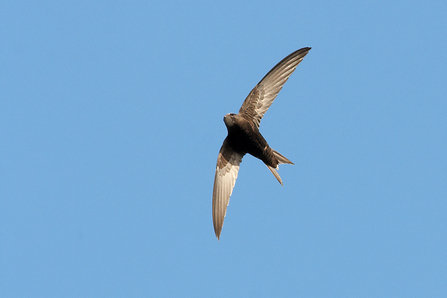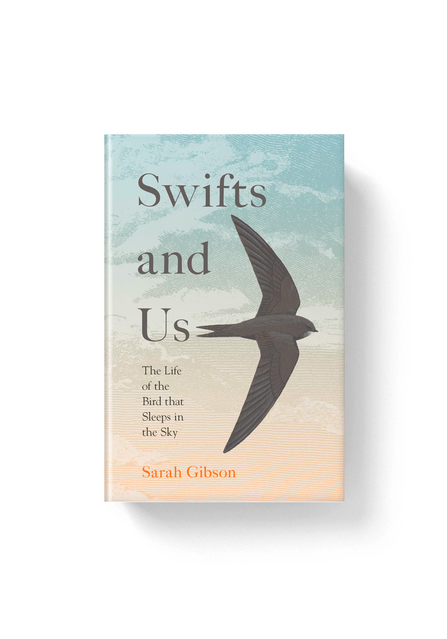“And here they are, here they are again”! Ted Hughes thrills to the swifts when they return to these shores in May. These are the first birds in a series of waves of swifts, arriving at different times according to their age and purpose. Breeders get here first, speeding back to reclaim their nests, meet up with their mates and get down to the serious business of raising a brood together. But swifts don’t generally breed until they are at least four years old (the average lifespan of a swift is seven or eight) so why do younger birds also make the 5,000-mile journey from Africa?
Swift Awareness Week
Swift ©David Tipling/2020VISION
Aerial life
These birds have been flying without cease ever since the moment they launched into the air from the safe, dark nest in which they hatched. From there they straightaway headed south for Africa: snapping up airborne insects, sipping water from lakes on the wing, preening their feathers in elegant aerial manoeuvres and spiralling up into the sky at dusk to sleep and orient themselves. Flying is simply what a swift does, all of the time, unless grounded by misfortune - most likely in the shape of persistent, torrential rain. However, their return to the part of the world in which they hatched is purposeful.
They come to seek a nest and a mate, and to establish their place within the loose, colonial territories that swifts form during the breeding season. Finding a nesting hole takes time but they have an instinct for suitable places and are often attracted by calls from their own kind. Swifts prefer to nest high up, under the eaves of buildings or in crevices in the masonry, searching for an entrance hole to a hidden space where they can make their dish-like nest of feathers, tree seeds and other materials blown up into the air and glued together with saliva.

©Stefan Johansson
Bangers
Early in the morning you might see them silently and leisurely flying around the eaves, sometimes brushing or knocking a wing against a likely hole. These are the ‘bangers’, young birds checking out whether these places are suitable, occupied or empty. If a hole has already been claimed, the resident swift will come to the entrance and scream at them to ‘clear off!’.
Another good way for them to find a nesting hole is to listen and look out for sparrows, which often (but not always) choose the same sort of places as swifts. Their insistent cheeping will show swifts just where these are. There may be scuffles between the two species – sparrows, like starlings, have been known to launch themselves on the backs of swifts to drive them off – but the bigger bird is usually the winner.
Spectacular circuits
Now, with the last wave of immature birds back in our skies, we have peak numbers of swifts to enjoy. It is the young, non-breeding birds which give us one of the most evocative and spectacular sights of summer. You may see them on a fine evening, racing their breath-taking aerial circuits in packs, searing the air with speed and screeching as they go. Swifts have been recorded flying at 69.3 miles per hour during these display flights. Breeding birds may sometimes come out and join them for a few circuits; it is a social activity that strengthens the bond between individuals in the colony, which may cover a street or a block. Maintaining territory helps reduce conflict between birds searching for nest sites.
Finding a nesting hole is the most crucial thing a swift has to do. Today though, that is becoming a tougher task. Renovation of old buildings almost always results in access to their holes being blocked, while new housing tends to be sealed completely against nature. Modern building materials, such as plastic soffits, offer little potential for future weathering and gaps opening up. Somehow, we need to make provision for nesting swifts – and urgently.
What you can do to help
Retaining existing nest holes is the best thing you can do as swifts are very site faithful. If carrying out roof renovation or insulation during the summer, ensure that access holes are not blocked by scaffolding and that they’re retained for the future.
Installing a swift box or two, at least five metres high, is a great way to help swifts but it can take time for the birds to find them. Playing swift calls can speed things up. If you’re thinking of buying a newly-built house, ask your builder to incorporate swift bricks.
Help swifts find food by gardening in a wildlife-friendly way. Insects from your garden may spiral into the air and be snapped up the birds.
Find out more ways you can help swifts in Suffolk:

Swift ©David Tipling/2020VISION
How to identify swifts, swallows and martins
Discover how to separate these similar species as they soar above you

Sarah Gibson works for Shropshire Wildlife Trust and is the author of Swifts & us: the life of the bird that sleeps in the sky, published by William Collins.


